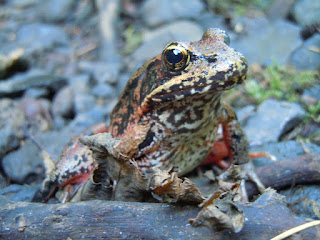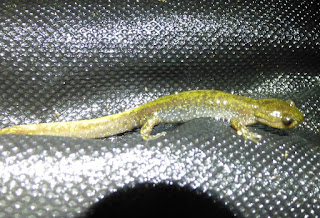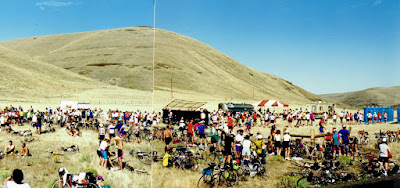 It’s a damp and pleasant night, and I’m plucking a perfect pink frog off a curtain of landscape cloth and placing her in a bucket. Which naturally puts me in mind of the Great Gilchrist-Crescent Spaghetti Feed of 1989.
It’s a damp and pleasant night, and I’m plucking a perfect pink frog off a curtain of landscape cloth and placing her in a bucket. Which naturally puts me in mind of the Great Gilchrist-Crescent Spaghetti Feed of 1989.
We are trying to keep the frogs from crossing Highway 30 on the way to their annual Spring Fling in a vernal pond. On our data sheets we refer to this as “assisting” them, which is not the verb the frogs use. In fact the case could be made that they lack appreciation.
 |
| Not a frog, but definitely landscape cloth |
We’ve got a slick system in place now. Our team has rigged up a temporary fence with landscape cloth to intercept the frogs before they cross the road. It’s a thing of beauty and was engineered chiefly by Anne the Magnificent, who has imagination and ingenuity and, ever since the election, plenty of time to think about things in the middle of the night. It’s a working wonder of rebar and old fence insulators and washers and string and clamps and pebbles and probably tractor innards and old hoof shavings and whatever else she could scavenge for free from her daughter’s farm, and it works like anything. Add in Maggie’s contribution–sewing eight hundred heroic feet of rope in a channel on the bottom of the landscape cloth for weight–and us frog wranglers, and we’ve got a well-oiled frog-plucking machine.
But it’s not as much fun as it used to be.
Before, we were scampering after the lusty hoppers all over the road and chasing them on the shoulder and clambering up to the railroad bed to coax them off the ties and scoping out their eyeshine on the berm and pointing and squealing and having us a fine old time. Lordy, it was invigorating. The hours go by like minutes when you’re frog-wrangling aerobically.
But of course we missed some of them. And it isn’t really safe to dash around a road in the dark. And the railroad company’s legal department was pretty particular about us not getting near their tracks. So great minds got together and produced this slick new system. And now we stroll the length of the cloth curtain like church ushers with a collection plate and scoop up frogs as we go.
 |
| Pootie in a younger day |
No more Gilchrist-Crescent Spaghetti Feed for us.
Oh, that! It was 1989. It was only the second year of the Cycle Oregon bicycle tour, before they’d ironed out all the kinks. 2,000 bicyclists were provided with campsites and luggage transport and dinner and water, but for most of the day we got a banana and a spank on the Spandex for luck and sent off for our ride. Any minor diner we came across during the day was stacked all around with bicycles eight feet deep and packed with cyclists, a wide-eyed waitress and a panicked fry cook. Little kids who set up cookie stands on the side of the road got cleaned out in minutes no matter what they charged. When we arrived in the logging towns of Gilchrist and Crescent, we were prodded toward the Grange Hall, where long tables sagged with homemade pies for sale–hundreds of them. We dispatched them like locusts on a corn crop. Then came dinner. Gilchrist-Crescent was ready. The community center was well-staffed and every large pot in town was set to boiling. Someone ladled tomato sauce out of a vat and everyone in town knew how many people to expect and how much spaghetti constituted a logger’s portion, but they were not familiar with 100-mile bikers. The garlic-bread distributor blanched at her dwindling supply and cut us down to a half-slice each. Progress in the line slowed and then ground to a halt as pickup trucks peeled off to nearby towns for more boiling pots and spaghetti. Those of us still waiting for dinner made a shoulder-rubbing conga line and sang ‘Sixties hits and put our left foots out and put our left foots in, and a fine and raucous time was had by all, even as the G-C womenfolk were living out their worst nightmares. It was like that all week. All 2,000 of us continued to vulture our way through miles of rural Oregon leaving behind a cleaned carcass of exhausted and astounded residents and a fair amount of money. It was grand.
But it would not do.
Cycle Oregon felt a bout of organization coming on, and got out its pencils and spreadsheets and calculators and thereafter delivered a precise and reliable 7,000 calories per day per person. Roadside cookie-stand business slumped. Waitresses waved from diners. Not many cyclists dropped dead. Order was restored.
It’s 2017, and smashed frogs and starved bicyclists have been reduced to an acceptable minimum. It’s a good thing. It’s efficient.
It’s just not as much fun.

Once something develops a similarity to an assembly line, the fun is just sucked out of it, innit? Some of us are always looking to streamline the process — we're just wired that way. Alas, it is spontaneity that makes room for fun to happen, and assembly lines don't work well with spontaneity. So no more fun. QED.
The spaghetti feed reminds me of the spaghetti dinners that our church had, back when I went to Catholic school. They enlisted the girls in our class to be servers, and the boys to wash dishes. It was fine until they ran out of meatballs. An angry patron yelled about the lack of meatballs to me. I started crying. He realized that he was yelling at a little girl, not a real waitress, and handed me some money. I earned my first tip! This experience did not deter me from waitressing, which served me well most of my adult life. I even was known to employ theatrics from time to time to get better tips. On one notable occasion, a coworker spilled a cup of coffee on me. It wasn't really hot, but I screamed anyway, and held my hand tenderly for the lunch rush. I made amazing pity tips that day!
Unless you can turn an assembly line into a conga line! Ooo, just got a delightful internal image of a 1920s Ford assembly line, in sepia.
I was a wretched bad waitress. Best tip I got was when I dumped coffee into a customer's lap. Although part of that might have been the way I dabbed him dry.
Good job on the frogs! I would NEVER go biking for a hundred miles (assuming I wouldn't die) without being self contained in the food and water department. Not that I couldn't stand to miss a meal now and then.
Oh yeah–they ran out of water once too. It was a hundred degrees that day. That could have turned ugly.
Thanks for you frog saving efforts and the telling of them. Both are magnificent.
Well, Anne and Maggie sure are–I'm just along for the ride!
Sounds like a lot of fur–& WORK!!
Excellent typo! We'll leave it in, shall we? Reminds me of that time-honored expression, "fine as frog hair."
I would never have predicted where you were headed with this. Since I have a frog loving friend I am going to ask her if they have every tried this.
Honestly? I don't always know where I'm headed with these things either.
Like Jono, I'd have to be packing my own supplies too … except then the bike would be too heavy for my ability to make it go in a forward motion. This is why I hate to exercise.
Great story. I'm sorry the fun got sucked out of stuff, but at least you have the memories of the fun. Pity all the newcomers who think it was always so efficient and soulless.
I kind of pity the Cycle Oregon newcomers, because that was some grand chaos back when, but the frogs are STILL FUN because FROGS!
I wasn't sure…I thought the cyclist sustenance was going to feature cuisses de grenouilles et l'ail.
Non non! No grenouille cuisses ici!
Boy,you go a bit of every which way on this blog, don't you…makes visiting here fun.
My mind wanders, but it's usually home in time for din din.
I was told not to let my mind wander as it's too small to be out by itself.
I'm stealing that.
I once encountered a huge amount of frogs crossing Maplelane here in Oregon City. It was at night and I stopped, rather surprised. I sat waiting for the large group to finish hopping across and thankful there was no traffic in either direction. After 15 min or so, I was able to start going again.
Speaking of bicycles, made me wonder if you ever participated in the Naked Bike ride.
Tell the truth,…
Truth is, I've been invited by two friends two different years, and one is young and one is not, and both times it fizzled out for one reason or another. I'm not agin it. Maybe this year!
Efficiency does tend to take the fun out of things and after a while some people drop out because there's little or no fun to be had, then when numbers get down to a certain point the whole things is called off because of "lack of enthusiasm".
I don't see that happening with the frog-pickers though, you people are in it for the long haul and the frogs don't care about efficiency.
We're not having an enthusiasm deficit. I say it's not as much fun but that's only because it was a HEAP of fun before, and now it's only REALLY fun.
Here's a good-news story from yesterday about salamanders crossing the road, Murr:
http://www.msn.com/en-ca/news/canada-day/ontario-city-to-close-road-for-salamander-crossing/ar-AAo1P8a?li=AAggv0m&ocid=mailsignout
If for some reason the link doesn't work for you, let me know and I'll copy/paste it in an email if you like.
"Efficiency kills fun." Words to live by.
The corollary is "Fun = Chaos." Not NECESSARILY words to live by.
In the 50's my dad and I would stop in Gilchrist (one of the last 'company towns') to eat in the restaurant in the big red building (all the buildings, including the houses, were red in the town). They had excellent biscuits and gravy.
Nearby is the Little Deschutes river, which does have a few frogs.
I've never had non-excellent biscuits and gravy. I miss that, now that I'm avoiding wheat.
Your recounting of The Spaghetti Feed put me in mind of the Alice's Restaurant Massacree. I think it was this lovely run-on sentence:
"Those of us still waiting for dinner made a shoulder-rubbing conga line and sang 'Sixties hits and put our left foots out and put our left foots in, and a fine and raucous time was had by all, even as the G-C womenfolk were living out their worst nightmares."
Like the Group W bench – ya know? But with bicycles…
I'd forgotten all about that!
"Not many cyclists dropped dead." Belly-laughable! You are a HEAP of fun.
Awww.
Thank you, your article is very good
viagra asli usa